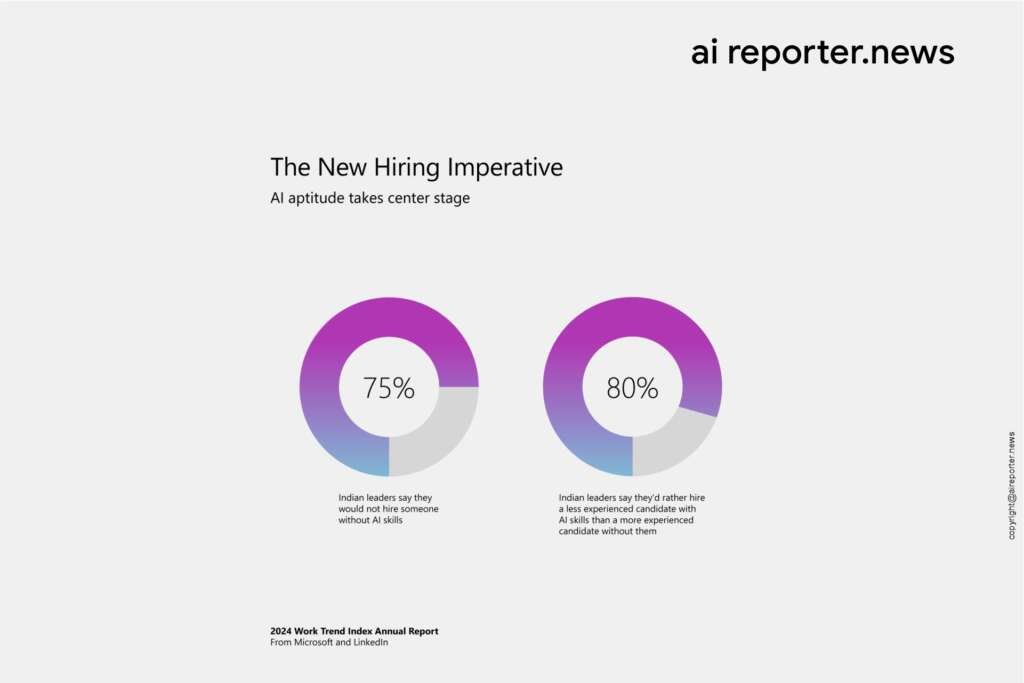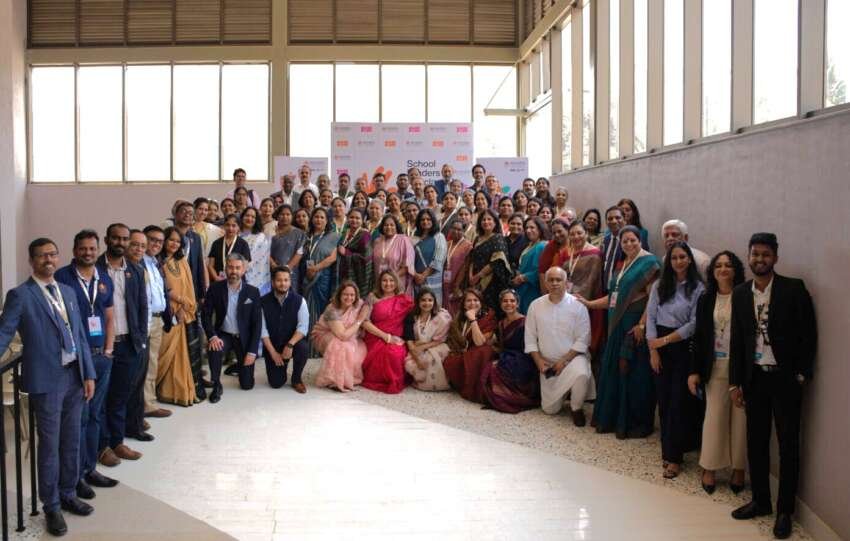
92% of Indian Knowledge Workers use AI in the Workplace
- LinkedIn is seeing a significant increase in professionals adding AI skills to their profiles.
- 91% Indian leaders believe they need to adopt AI to stay competitive, 54% worry their organization lacks an AI plan
BENGALURU, India (AI Reporter/News): Microsoft and LinkedIn has released the India findings of the 2024 Work Trend Index on the state of AI at work. The report titled, “AI at work is here. Now comes the hard part” shows how, in just one year, AI is influencing the way people work, lead and hire. The report spotlights employees’ strong desire for AI integration in the workplace, the opportunities it creates for career growth, and the emergence of AI power users1 in the future of work.
Microsoft and LinkedIn partnered for the first time for the fourth Work Trend Index to provide a comprehensive view of how AI is shaping work. The findings are based on a survey of 31,000 people in 31 countries, labor and hiring trends on LinkedIn, trillions of Microsoft 365 productivity signals and research with Fortune 500 customers.
The report highlights insights every leader and professional needs to know about AI’s impact on work, talent and hiring in the year ahead:
1. Employees want AI at work—and won’t wait for companies to catch up
India’s workforce is very optimistic about AI. Ninety-two percent of knowledge workers in India use AI at work as compared to the global figure of 75%, reflecting employee confidence in AI to save time, boost creativity, and focus. Ninety-one percent of leaders in India also believe their companies need to adopt AI to stay competitive, 54% worry their organization lacks a plan and vision for implementation.
While leaders feel the pressure to turn individual productivity gains into organizational impact, employees aren’t waiting to reap the benefits: 72% of Indian AI users are bringing their own AI tools to work (BYOAI). The data is clear: people are turning to AI to be more productive and creative at work. The opportunity for every leader is to channel this momentum into ROI.

“We’re at the forefront of integrating AI to not just work faster, but to work smarter. It’s our responsibility as organizational leaders to ensure that this technology elevates our teams’ creativity and aligns with our ethical values.”
—Karim R. Lakhani, Chair, Digital Data Design Institute at Harvard, and Dorothy & Michael Hintze Professor of Business Administration at Harvard Business School
“These findings align perfectly with how our brains manage the trade-offs between routine task execution and innovation—different kinds of thinking supported by two distinct but interacting neural networks in the brain. When we’re constantly switching, we don’t work as well. AI can help liberate workers from menial work and enable innovation and creativity to flourish.”
—Michael Platt, neuroscientist and professor at the Wharton School of the University of Pennsylvania
2. For employees, AI raises the bar and breaks the career ceiling
In a world where AI mentions in LinkedIn job posts drive a 17% jump in response rate, it’s a two-way street: organizations that empower employees with AI tools and training will attract the best talent, and professionals who skill up in AI will have the edge.
For India’s leaders, AI skills are now a top priority when it comes to hiring, with 75% stating they wouldn’t hire someone lacking in AI skills, outpacing the global average of 66%. Interestingly, AI skills outweigh experience, with 80% of leaders in India preferring to hire a less experienced candidate with AI skills, over a more experienced candidate without them.
As of late last year, there has been a 142x increase globally in LinkedIn members adding AI skills like Copilot and ChatGPT to their profiles and a 160% increase in non-technical professionals using LinkedIn Learning courses to build their AI aptitude.
“Over the past few decades, companies have been renegotiating the psychological contract—the why of work—with their employees, influenced by new generations, labor trends, and the pandemic. Now companies must renegotiate the ‘operational contract’—the how of work—with their employees as AI puts more power into the hands of workers in terms of the way the job gets done.”
—Constance Noonan Hadley, Organizational Psychologist, Institute for Life at Work and Boston University Questrom School of Business

3. The rise of the AI power user—and what they reveal about the future
Four types of AI users emerged in the research—from skeptics who rarely use AI to power users who use it extensively, with novices and explorers in between. Compared to skeptics, AI power users have fundamentally reoriented their workdays with 90% of Indian AI power users beginning their day with AI and 91% relying on it to prepare for the next day. They are also 37% more likely to seek guidance from co-workers regarding useful prompts and 47% more likely to experiment with AI.
AI power users are nearly 20% more likely to receive training, particularly on prompts and role-specific AI usage, compared to other employees. They are also 65% more likely to receive communication from the CEO on generative AI, 34% more likely from the function or department lead, and 44% more likely from their manager’s manager.
“To stay ahead of the curve, we’ve made AI training a priority to ensure everyone can leverage the power of Copilot for Microsoft 365 and other AI solutions. We also launched the GenAI Academy, supporting employee growth and development with the aim of increasing ambassadors and GenAI power users across the globe. We are already seeing benefits that are transforming the way we work and innovate.”
—Sheila Jordan, SVP, Chief Digital Technology Officer, Honeywell

AI is now a reality at work, with India having one of the highest AI adoption rates
Irina Ghose, Managing Director, Microsoft India and South Asia said, “Data from the Work Trend Index shows that AI is now a reality at work, with India having one of the highest AI adoption rates among knowledge workers, at 92%. The rate of diffusion we’re seeing across sectors, from BFSI to healthcare to ITES and the public sector has been very encouraging. This AI optimism presents a tremendous opportunity for organizations to invest in the right tools and training, to unlock efficiencies for employees and ultimately drive long term business impact.”

*****
The demand for AI expertise has seen a remarkable 17% jump from last year
Ruchee Anand, Head of Talent & Learning Solutions at LinkedIn said, “AI is transforming the world of work, reshaping the talent landscape and nudging both individuals and organizations to embrace change. The demand for AI expertise has seen a remarkable 17% jump from last year, echoing LinkedIn platform insights and findings of the Work Trend Index. We’ve seen professionals in India over index on learning while also adding AI skills to their professional toolkit. As the workforce looks to tap into the benefits of AI, it’s crucial for leaders to boost their organization’s AI capabilities through thoughtful investment in both technology and talent.”

Use of generative AI at work has nearly doubled in the last six months, globally.
LinkedIn is seeing a significant increase in professionals adding AI skills to their profiles. However, with every second leader in India worried that their company lacks an AI vision and employees bringing their own AI tools to work, leaders have reached the hard part of any tech disruption: moving from experimentation to tangible business impact.
On the sidelines of the report, Microsoft announced new capabilities in Copilot for Microsoft 365 to help people get started with AI, and LinkedIn announced over 50 learning courses that are being made free to empower professionals at all levels to advance AI aptitude.
· Some of the new capabilities introduced in Copilot for Microsoft 365 include: Copilot will become more conversational by suggesting follow-up prompts or asking clarifying questions to provide the best response possible.
· A new chat interface in Copilot will proactively offer timely recommendations based on recent activity, like “You missed Tuesday’s sales meeting. Here’s a quick summary” or flagging an important email for follow up.
· The prompt box in Copilot will now have an auto complete experience, allowing users to get better results from their prompts. If you’ve already written the prompt, a new rewrite feature will turn basic prompts into rich ones, grounded in your work meetings, documents and emails.
· Updates to Copilot Lab will allow employees to create, publish, and manage prompts that are expressly tailored to their team.
In addition to the 50 new AI learning courses available for free through July 8, LinkedIn offers:
· AI-powered coaching with personalized content and conversational learning.
· AI-powered personalized takeaways on LinkedIn Feed offering insights, ideas and actions.
· AI-powered tools to assess fitment for a role based on experience and skills match, plus advice on how to stand out and suggestions for skill building.
Copilot Study: How AI Could Reshape the Workday
Microsoft researchers designed a six-month randomized control trial of 60 Copilot customers across industries. The study is the first mass-scale observation of 3,000 individuals using AI in their natural work environment with no interventions from the researchers to encourage use. Preliminary results show how AI could reshape the anatomy of the workday in fundamental ways—reducing time spent in inboxes, making meetings more valuable, and increasing time spent on high-value focus work.

Emails: Overall, Copilot users read 11% fewer individual emails and spent 4% less time interacting with them. The customers who saw the most impact spent 25%–45% less time reading emails.

Meetings: In some companies time spent in meetings increased, in others it decreased. One hypothesis is that AI makes meetings more valuable—as stores of information and a shortcut to creation, like a brainstorming meeting, easily turned into a first draft. For some companies, the increased efficiency leads to fewer meetings, and at others the increased value leads to more. As AI capabilities progress, researchers expect this effect to continue—allowing us to reduce time in some meetings while making the meetings we do have more valuable.

Documents: Overall, Copilot users edited 10% more documents in Word, Excel, and PowerPoint—the companies that saw the largest impact noticed a 20% increase. This may suggest that people are repurposing the time they save for high-value focus work like creating and consuming information.
Key Insights from Microsoft and LinkedIn’s 2024 Work Trend Index on AI Adoption in India
| Fact | Detail |
|---|---|
| AI Usage Among Knowledge Workers | 92% of Indian knowledge workers use AI at work, compared to 75% globally. |
| Leaders’ Perspective on AI | 91% of Indian leaders believe AI adoption is necessary to stay competitive. |
| Concerns About AI Implementation | 54% of Indian leaders worry their organization lacks an AI plan. |
| Employee Initiative | 72% of Indian AI users bring their own AI tools to work (BYOAI). |
| AI in Hiring | 75% of Indian leaders prioritize AI skills over experience in hiring. |
| Increase in AI Skill Acquisition | 142x increase in LinkedIn members adding AI skills, 160% increase in non-tech professionals using LinkedIn Learning for AI. |
| AI Power Users in India | 90% start their day with AI, 91% use AI to prepare for the next day. |
| Training and Communication | AI power users are 20% more likely to receive AI training, and 65% more likely to get AI communication from CEOs. |
| Generative AI Adoption | Use of generative AI at work nearly doubled globally in the last six months. |
| Microsoft and LinkedIn Initiatives | New AI capabilities in Copilot for Microsoft 365 and over 50 new free AI learning courses on LinkedIn. |
copyright@aireporter.news


